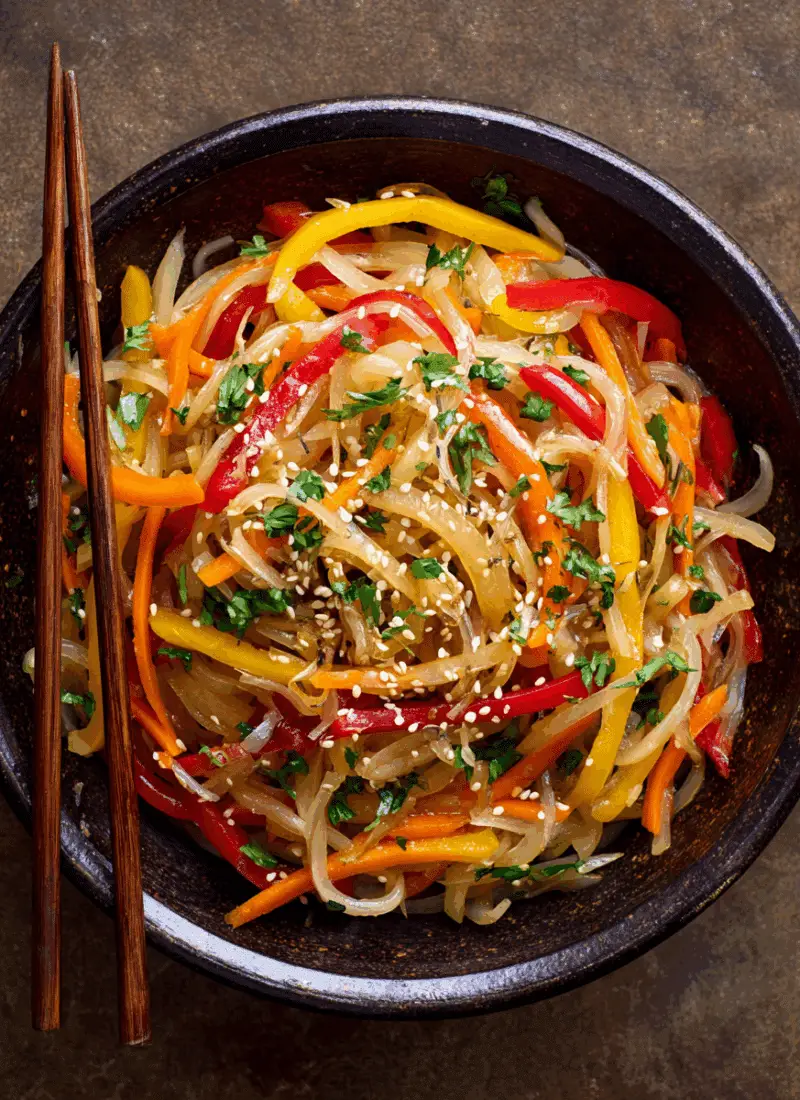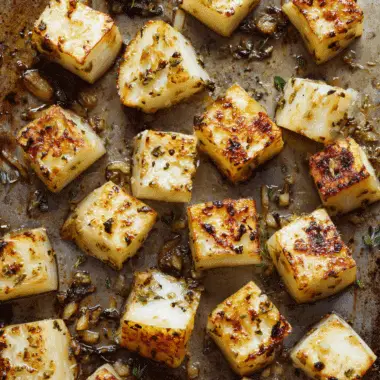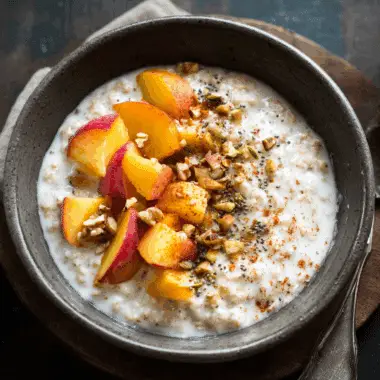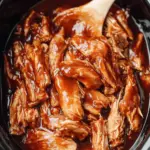Kohlrabi Stir-Fry is a simple, wholesome, and vibrant dish perfect for busy weeknights. This veggie-packed stir-fry highlights the crisp, slightly sweet flavor of kohlrabi, complemented by carrots, bell peppers, and a light soy-ginger sauce. It cooks in minutes and can be served with steamed rice, noodles, or even on its own as a low-carb main.
FULL RECIPE
Ingredients
- 2 medium kohlrabi, peeled and julienned
- 1 medium carrot, julienned
- 1 red bell pepper, thinly sliced
- 1 small onion, thinly sliced
- 2 cloves garlic, minced
- 1-inch piece of fresh ginger, grated
- 2 tablespoons soy sauce (low sodium if preferred)
- 1 tablespoon sesame oil
- 1 tablespoon vegetable oil (for cooking)
- 1 teaspoon rice vinegar (optional for brightness)
- 1/4 teaspoon red pepper flakes (optional, for heat)
- 2 green onions, chopped (for garnish)
- 1 tablespoon toasted sesame seeds (optional)
- Cooked rice or noodles, for serving (optional)
Directions
- Heat vegetable oil in a large skillet or wok over medium-high heat.
- Add sliced onions and sauté for 2–3 minutes until slightly softened.
- Stir in the garlic and ginger, cooking for another 30 seconds until fragrant.
- Add the julienned kohlrabi, carrots, and bell pepper to the pan. Stir-fry for 5–7 minutes, or until vegetables are tender-crisp.
- Drizzle in the soy sauce and sesame oil, tossing well to coat all the vegetables evenly.
- Add rice vinegar and red pepper flakes if using. Stir and cook for another minute.
- Taste and adjust seasoning if needed.
- Remove from heat and garnish with chopped green onions and sesame seeds.
- Serve hot on its own or over a bed of rice or noodles.
Nutrition Facts
- Calories: 140
- Protein: 3g
- Carbohydrates: 15g
- Dietary Fiber: 4g
- Sugars: 7g
- Fat: 8g
- Saturated Fat: 1g
- Sodium: 410mg
- Vitamin A: 90% DV
- Vitamin C: 100% DV
- Calcium: 6% DV
- Iron: 6% DV
Health Benefits of Kohlrabi Stir-Fry
Kohlrabi stir-fry is a nutrient-rich dish that offers a variety of health benefits thanks to its diverse mix of vegetables. Kohlrabi itself is a cruciferous vegetable packed with fiber, vitamin C, and antioxidants that support immune function and digestion. When combined with colorful vegetables like carrots and bell peppers, the dish becomes a powerhouse of vitamins A and K, beta-carotene, and polyphenols. The inclusion of garlic and ginger not only boosts the flavor but also adds anti-inflammatory and immune-boosting properties. Altogether, this stir-fry is low in calories, free from refined sugars, and packed with plant-based nutrients that make it an ideal addition to a balanced diet.
Flavor Profile and Texture
The flavor of kohlrabi stir-fry is delightfully fresh, slightly sweet, and mildly peppery, reminiscent of a cross between cabbage and broccoli stems. When stir-fried, kohlrabi retains a crisp-tender texture, offering a pleasant contrast to the softer, sautéed bell peppers and onions. The addition of soy sauce, garlic, and ginger introduces umami, warmth, and a slight zing to the dish, creating a balanced flavor profile that’s both savory and vibrant. The optional drizzle of sesame oil adds a rich, nutty aroma that elevates the dish’s complexity without overpowering the vegetables’ natural sweetness.
Popular Variations to Try
There are many ways to customize a kohlrabi stir-fry to suit your preferences or dietary needs. You can add protein sources such as tofu, tempeh, chicken, shrimp, or thinly sliced beef for a more filling meal. For a spicier version, consider tossing in sliced chili peppers or a spoonful of chili garlic sauce. If you’re aiming for a more aromatic profile, try adding a splash of lime juice, Thai basil, or lemongrass. Vegetables such as snap peas, baby corn, mushrooms, or zucchini also make excellent additions. Gluten-free eaters can swap soy sauce for tamari or coconut aminos.
Serving Suggestions and Meal Pairings
Kohlrabi stir-fry is incredibly versatile and pairs well with a variety of main dishes or grains. It can be served as a side dish alongside grilled meats, tofu, or pan-seared fish, or as a main over a bed of jasmine rice, brown rice, or soba noodles. For a low-carb or keto-friendly version, serve it over cauliflower rice or shirataki noodles. A spoonful of crushed peanuts or a fried egg on top can transform the dish into a hearty one-bowl meal. For a complete Asian-inspired spread, pair it with miso soup or cucumber salad and finish with a light dessert like fruit sorbet or mochi.
Seasonality and Ingredient Availability
Kohlrabi is typically available in cooler months, making this stir-fry a great option during fall and winter when other fresh vegetables may be scarce. However, thanks to greenhouse production and improved distribution, kohlrabi can often be found year-round in well-stocked grocery stores or farmer’s markets. The other ingredients—such as carrots, onions, bell peppers, and ginger—are pantry staples that are generally easy to source. The simplicity and flexibility of this recipe make it especially appealing for home cooks who want to work with what’s in season or already on hand.
Storing and Reheating Leftovers
Kohlrabi stir-fry keeps well for a few days when stored properly, making it a convenient option for meal prep. After allowing the dish to cool, transfer it to an airtight container and refrigerate for up to 3 to 4 days. To reheat, simply warm it in a skillet over medium heat with a splash of water or broth to refresh the sauce and prevent sticking. Alternatively, it can be microwaved in short bursts, though this may slightly soften the vegetables’ texture. While freezing is possible, it may lead to a mushier consistency upon thawing, so refrigeration is the preferred method.
Kid-Friendly and Family Appeal
This stir-fry is an excellent way to introduce children and picky eaters to a wider variety of vegetables. Its vibrant colors and lightly seasoned flavor can appeal to young palates, especially when served with familiar sides like rice or noodles. You can reduce or omit the spicier elements, such as red pepper flakes, to make it more suitable for kids. Allowing children to help with peeling or stirring can also make them more interested in trying the finished dish. Adding small cubes of tofu or lean meat can further increase its appeal as a satisfying and nourishing family dinner.
Cultural and Culinary Inspiration
While kohlrabi is not traditionally associated with Asian cuisine, this stir-fry draws inspiration from common Chinese and Southeast Asian cooking techniques that emphasize quick cooking over high heat and the use of aromatic bases like garlic and ginger. The resulting dish pays homage to the essence of stir-frying—preserving texture, color, and flavor—while giving kohlrabi a fresh twist. It’s a fusion that honors both the vegetable’s European roots and the bold simplicity of Asian-style vegetable stir-fries. This cross-cultural approach makes the recipe uniquely adaptable to a wide range of tastes and cuisines.
Tips for Perfect Stir-Frying
Achieving a great stir-fry requires a few key techniques. First, ensure all vegetables are uniformly cut, preferably julienned, to promote even cooking. Second, use a large skillet or wok to allow enough space for the ingredients to cook quickly without steaming. Preheat the pan and cook in batches if needed to maintain high heat. Aromatics like garlic and ginger should be added early to release their fragrance, but not so early that they burn. Add sauces at the end of cooking to coat the vegetables evenly. Lastly, avoid overcooking to maintain that desirable crisp-tender texture.
Sustainability and Reducing Food Waste
Kohlrabi stir-fry supports sustainable cooking practices in several ways. Kohlrabi is a hardy, low-input crop that can grow in diverse climates, and its entire bulb and leaves are edible. In this recipe, while the focus is on the bulb, you can also incorporate the greens—sautéed separately or added to soups and smoothies—to reduce waste. The dish uses common ingredients that don’t require long transport or excessive packaging, helping lower your meal’s carbon footprint. Leftovers can be creatively reused in wraps or grain bowls, ensuring that no portion of this nutritious meal goes to waste.
Conclusion
Kohlrabi stir-fry is more than just a quick, weeknight dinner—it’s a celebration of fresh produce, efficient cooking, and creative flavor combinations. Its vibrant colors and crisp textures make it as visually appealing as it is delicious, while its flexibility invites endless variations. Whether you’re seeking a nutrient-dense vegan meal, a new way to enjoy seasonal vegetables, or a family-friendly dinner, this stir-fry checks every box. Easy to prepare, enjoyable to eat, and smart for your health and the planet, it’s a recipe worth keeping in your regular rotation.








